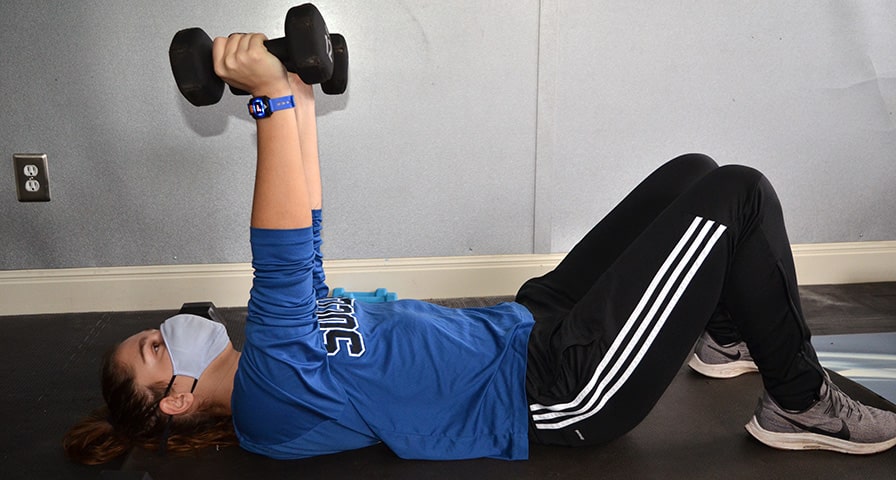Familiar Technology Gives Students a Sense of Comfort in Their Ever-Changing Learning Environment
Andrew Cherry ensured his Ellinwood Middle School/High School (Kan.) PE students could continue to wear their IHT ZONE heart rate monitors this year by working closely with his school administration to address concerns about students safely sharing equipment.
In the three years since Cherry first added the technology to his school’s PE program, the IHT ZONE monitors have become an integral part of his teaching. For two key reasons, Cherry didn’t want to go a year without using them. First, students expect to wear the monitors during class. Second, teachers can use the data to enhance their grading and provide essential feedback.
“The monitors are such a big part of what we do,” Cherry said. “The kids know their grade is based on what the heart rate monitor says, and they are buying in again. The majority of kids are still getting in the correct heart rate zones.”
Giving Students a Sense of the Familiar
Cherry, a nominee for Kansas Teacher of the Year in 2020, uses the IHT ZONE monitors with his students for both physical and emotional reasons. Beyond what students learn from their heart rate data, Cherry wanted them to have something that hadn’t been turned on its head by the pandemic.
“It’s been a tough year with the things that we are asking students to pay attention to,” Cherry said. “When students come into the gym, they see a lot of the same stuff that they are used to, and that includes wearing the heart rate monitors. I think that’s an ease to their mind.”
That sense of comfort, Cherry said, has enabled students to get back to work, even if there are still constant reminders that things are far from normal.
“I feel it too,” Cherry said of the emotional challenges. “Wearing masks, we can only see half of each other’s faces, and that makes it tough to form the same kind of connection we’re all used to having.”
Like his students, Cherry’s trying to make the best of the current situation.
“We are just trying to do the best we can, giving the students something they recognize and can be excited about,” Cherry said. “If we can build their physical health, we hope the mental and emotional health gets built along with it.”
Building Students’ Physical Health
In his PE classes, Cherry combines the motivating factor of the IHT ZONE with a modified approach to his traditional PE curriculum.
“We’re trying to limit any equipment connections [in our activities],” he said. “We are not sharing things. We looked for units that fit with limited equipment sharing and tried to increase the space between students.”
A mild fall allowed students to spend time outside of the gym, which allowed them more opportunities to practice social distancing. Cherry’s activities included:
- Walking for distance;
- Scavenger hunts; and
- Frisbee golf.
If students did use equipment, such as discs for frisbee golf, each used the same disc throughout the class and then cleaned it (wiped it down with a sanitary wipe) before putting it away.
The constant, Cherry said, remained the IHT ZONE monitors. Students wear them in each class, and throughout the first semester, Cherry challenged them to keep their heart rates elevated – in yellow or red zones – for the bulk of the activity. Students pushed themselves to walk briskly or run to gather their frisbee before taking their next shot.
“In my classes, I feel like they are excited to be active and are getting more motivated,” he said. “The ZONE still makes a difference. They see it change color and that motivates them to keep it out of the blue zone.”
Focus on Safety with Shared Devices
Despite COVID-19 forcing drastic changes on the way schools in many states are functioning in 2020-21, Cherry knew from the beginning of the year that he wanted to keep using his heart rate monitors. As administrators made plans for the year, he took the initiative and advocated for his program.
“When we were talking about going remote or being socially distanced, there was talk that PE was going to be cut,” Cherry said. “We still need to have our classes. I went to them at the beginning and asked, ‘what do you need me to adapt?’ They gave me a list of things they wanted me to do and I addressed it.”
It helped, as well, that the community has not been as significantly impacted by COVID as others around the country. In spite of the low COVID numbers, Cherry knew the administration would focus first on how he proposed to keep things sanitary from class to class.
“We have hand sanitizer dispensers everywhere,” he said. “We figure if hands are clean at the start of class and again at the end, then we’re doing that much more to minimize risk.”
Everyone also does more than they’d done in the past to keep monitors clean throughout the day.
“We clean them before and after each use. We didn’t really do that in the past, and probably we should have been doing that,” Cherry admitted. “There are a lot of things that we are doing today that we probably should have been doing all along.”
Each class follows a simple protocol. Students sanitize their hands when they come into the gym, then wait their turn to pick up their IHT ZONES, which had been cleaned by the previous class. Following use, each student sanitizes their hands again and then wipes down their ZONE with a special wipe before putting it back in the charging case and the process repeats throughout the day.
The protocols have worked. Cherry’s students have logged more than 500 class sessions with their IHT ZONES this year. While the lessons have changed, he takes comfort knowing the heart rate monitors still bring out the best in his students.
“We have done a lot with minimal to no equipment [this year],” he said. “It’s important to know that you can still get a lot out of these students.”



